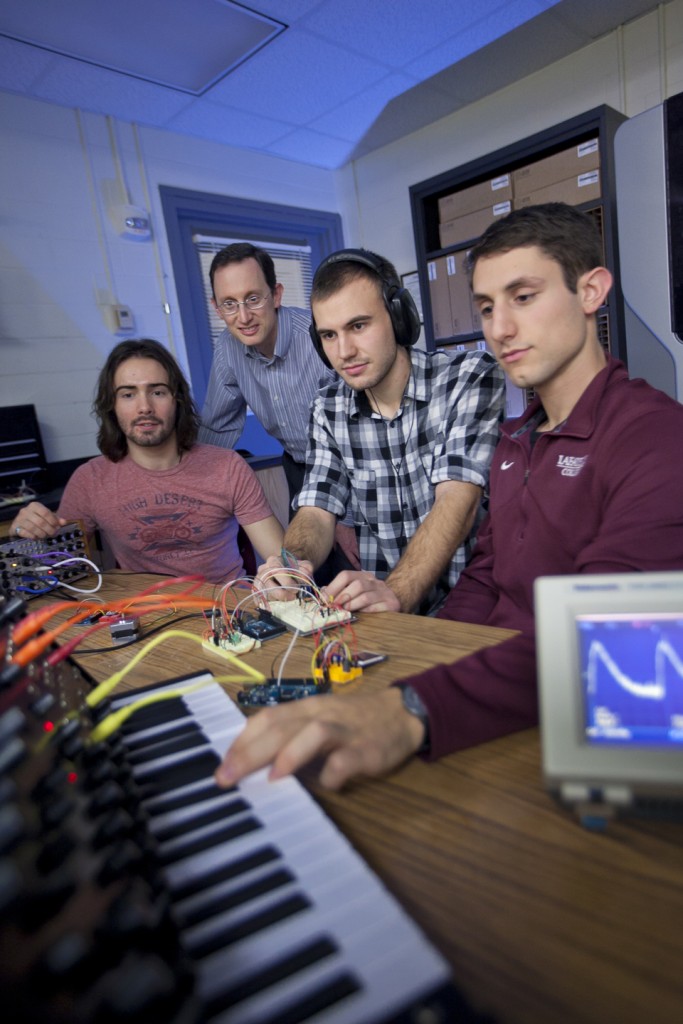Engineering Unleashed: Lafayette’s X-Trained Engineering Initiative
Initial plans include setting the groundwork for a X-Trained (Cross-Trained) Engineering Initiative to introduce engineering students to the knowledge, perspectives, skills, values, and mental agility that contribute to an entrepreneurial mindset. This mindset fosters thinking beyond the technical challenges of a problem to consider its humanistic, artistic, economic, and social dimensions.
“Engineering is about people. It’s about making peoples’ lives better,” says Scott Hummel, William A. Jeffers Director of the Engineering Division. “The three attributes of the entrepreneurial mindset — curiosity, connections, and creating value — align perfectly with this principle. This is what we want to teach our students: To find a technical solution to a problem that considers the many social, environmental, economic, and political factors surrounding the people affected by the solution.”
The initiative builds on Lafayette’s success in providing generations of engineering students with an outstanding technical education coupled with abundant opportunities for immersion in the liberal arts. The program also aligns with the key objectives of the College’s Live Connected, Lead Change campaign to further connect the liberal arts and engineering, foster innovation in teaching and learning, and connect the campus community.
Entrepreneurial Mindset Learning (EML) in the curriculum
A systematic approach is being used to infuse EML at various levels in the four-year degree programs. This began with the cornerstone course Introduction to Engineering (ES101) with various modules related to the entrepreneurial mindset in fall 2015. For example several modules of ES101 integrated entrepreneurial learning into the design project. Students were asked to identify an opportunity, investigate a market, create a preliminary business model, communicate engineering solutions in economic terms, and examine and consider societal impacts and needs.
Capstone and upper-level project courses are another curricular area where EML is being adopted by faculty members. Introduction to Environmental Engineering & Science (CE321) looked at how adaption to climate change presents new business opportunities for engineers. Industrial Electronics and Control Systems (ECE433) included a term project for students to work in teams to propose and design motor control systems for industrial applications. In ChE312, Experimental Design I, students were introduced to “customer-focused” labs. The senior design project in ME497 featured a collaborative multi-disciplinary design project focused on product design for the aging population.
Embedding EML into the engineering curriculum encompasses opportunities for faculty members to investigate and apply non-traditional educational methods. The possibilities range from flipped classrooms and online modules, to developing an interim or spring-break-intensive EML program.
EML in motion

Professor Daniel Sabatino and his students are working on an interdisciplinary project that would modernize traditional modular analog synthesizers.
An interesting example of EML at Lafayette is the Moog project. Daniel Sabatino, assistant professor of mechanical engineering, is leading the experimental project backed by the X-Trained Engineering Initiative. His students are studying modular analog synthesizers, popularized by Dr. Robert Moog. These ‘70s dinosaurs are back in vogue largely because musicians find them more interactive and creative than computers.
The students are working with musician, composer and producer Al Sgro from Los Angeles to explore the development of new synthesizers that move beyond the original technology and create an instrument that is different than anything currently available. Kirk O’Riordan, assistant professor of music and director of bands, is actively involved, and the team has received interest from economics and the electrical and computer engineering departments as well as assistance from psychology. The team hopes to include students and professors from the neuroscience program to better understand what attracts musicians to the older analog equipment and how to incorporate the most valuable aspects of the old into the new.
“This project highlights how the KEEN framework, emphasizing curiosity, connections, and creating value, perfectly complements Lafayette’s mission to develop critical thinkers who can translate their knowledge and skills into creative endeavors that have impact,” Sabatino says. “It’s a great experience for the students because they learn to rely on what they have learned, as well as each member’s individual strengths, in order to create something truly needed out of such a large and unbounded problem.”
While the technical aspects of building a Moog are a focus of the project, the human elements involved raise questions that will be equally significant: What is attracting contemporary musicians to this type of older equipment? Why did the use of Moogs die out in the first place? How can the equipment be improved upon in a contemporary environment? How has the enthusiasm for this type of equipment evolved? What is the market for a modern-day Moog?
The project offers a wealth of entrepreneurially minded learning opportunities beyond the scope of the traditional teaching of a particular skill set. Students use their own curiosity to identify value in something end users are not explicitly identifying. Once the value is identified, students will follow the typical design process to design, build, test, and modify a prototype to deliver that value, making connections along the way as they integrate information and learn to think strategically as well as operationally.
EML beyond the classroom
In addition to coursework, co-curricular activities augment the classroom experience. Guest speakers, workshops, and symposia explore such areas as business acumen, intellectual property, professionalism, venture capital, non-profit management, etc.
While Lafayette Engineering’s emphasis on experiential learning has always provided a distinguished technical education, when furthered with the entrepreneurially minded learning of the X-Trained Engineering Initiative it provides engineering students with the opportunity to become more creative and better problem solvers. Students better understand the social, economic, and human setting for addressing complex challenges. They see problems as opportunities to make peoples’ lives better and move society forward.